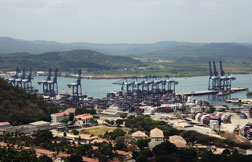 C.J. Schexnayder/ENR Balboa Port, Panama City, Panama.
|
Each day thousands of cargo containers cross almost 50 miles of the Isthmus of Panama. But they aren’t going through the famed Panama Canal.
In the past five years, traffic on a 47.6-mile railroad has jumped. It is a cooperative system between Panama Ports Co.—which operates primary container ports on both sides of the isthmus—and the Panama Canal Railroad Co.
“The canal is the magnet that draws the cargo here,” says Dave Starling, president of the Panama Canal Railway Co. “Once the cargo is in Panamanian waters you have the opportunity for transshipment.”
“Panama is the only place in the world where you have dual-ocean transshipment,” he adds. “You can unload it on one ocean; we move it across...there are no liquidation or customs issues, and [the cargo] catches a vessel on the other ocean.”
The railroad is operated by a consortium led by Kansas City Southern Railway Co. and Mi-Jack Products, Hazelcrest, Ill. Expansion may be needed within the next seven years despite a $70-million upgrade in 2001. Last year, the railroad moved 115,000 containers, a 190% increase from 2005. “A million containers per year is possible,” says Starling.
The massive expansion under way at the Balboa transshipment port on the Pacific Ocean will make it possible. The expansion, managed by The Louis Berger Group, East Orange, N.J., will include five contracts to be let this year. The first, for dredging, was announced in February. This work is the last of a three-phase expansion begun in 1998 that has cost $320 million. “Upon completion it will more than triple the capacity of the port and allow multiple post-Panamax ships to dock there,” says Carlos Marcenaro, Berger senior vice president. After 2012, the port will hold 5 million containers annually—five times more than now.
The project envelopes 60 hectares, with 40 currently submerged hectares to be filled in. More than 1 million cu m will be dredged and the quayside draft increased from 10 m to 14 m. “Almost all of the reclamation is behind the existing quay, and as a result access to the construction area is very limited,” says Jorge Puente, Berger senior projects manager. “All of the fill material will have to be brought in by water.”
The Manzanillo International Terminal near the Atlantic opening of the canal is beginning the $200-million first phase of a similar improvement program. Last month PSA International announced a plan to construct and operate a container terminal at the Pacific entrance to handle 450,000 TEUs per year.
 Related Links:
Related Links: 
Post a comment to this article
Report Abusive Comment